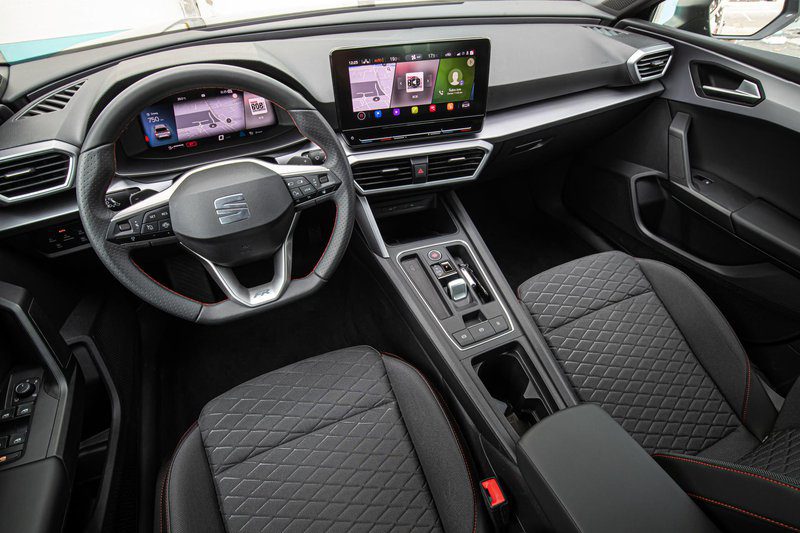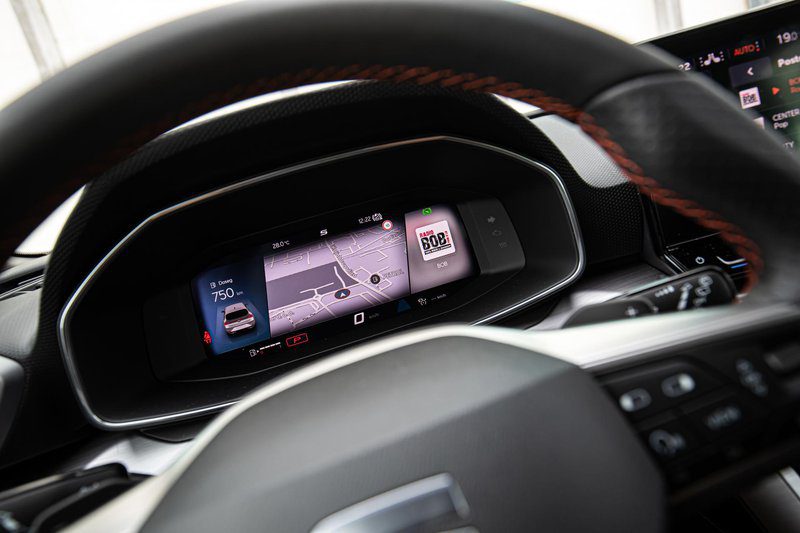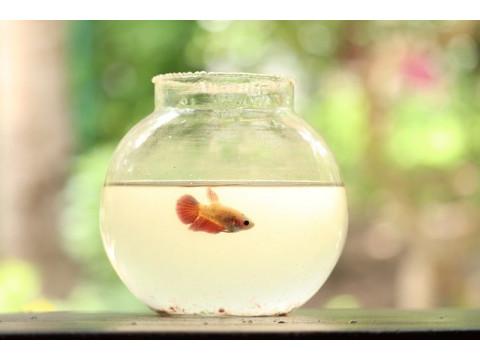
Test: Seat Leon FR 2.0 TDI (2020) // When less is better
Content
So at Seat they finally woke up. Leon, who has traditionally been the brand's standard bearer, is no longer the sincere and sovereign first due to the flood of SUVs and crossovers, but still important enough to give him a new design language that unites what he is now more emotional, distinctive and with with several interesting solutions. This makes it more dynamic, but also more compact ...
While on a new platform MQB made Leon really work even more compact, the car has grown a lot in the last, that is, in the fourth generation. To a large extent, I have to say, because it is noticeable that this is simply not the case, and the machine works even less. However, in reality, the novelty is almost nine inches longer than the previous model. However, his portrayal is more consistent because they pushed the wheels closer to the edges of the body, reduced overhangs, and optically made the Leon look smaller than he actually is at 4,36 m.

Of course, even in the latest version, this is a car that would be bought not because of the centimeters, but because of the consistency and moderate ratio between the outer centimeters and the spatial comfort inside. However, the novelty here, of course, has much more to offer than its predecessor. All the extra inches are even more familiar in the back seat, where passengers are no longer in a second class position.where the seats are comfortable, but not luxurious, but quite decent for the taller ones and, if necessary, for the triples.
The driver's cab retains some hint of sporty crampedness, although there is generally more room and better utilization. The materials are better and the digitization is complete again, just like the relatives of the group. Say goodbye to physical switches, forget about shortcut switches as a kind of digital reality solution... Welcome to the world of digitalization, where everything happens on the center screen of the infotainment system and where the logic is unique to each brand.
This is one of the reasons why, after spending time with relatives from the concern, it took me a long time to master the logic of work and the way of thinking of programmers. I admit that Leon was who I needed the most time to be at home. Of course, a few days later, when everything finally cleared up, I wondered how, but I did not understand ... But, apparently, this is really just a matter of habit and adaptation.

Once I fully mastered the work and logic, the touch home screen with all layouts was already quite logical. Well, something might need to be upgraded, but that's the advantage of these systems. - when after some time the factory finds that a virtual extra switch may be required or that the image is too large, the programmer will edit it and the update will follow over the air. Fast, easy, and most importantly - cheap ...
But do not be afraid - this certainly does not affect the mechanics and ergonomics! And I dare say that few people will not be able to sit comfortably and relaxed behind the wheel of this Leon. There is ample room for adjustment both on the seat and on the steering wheel, and the seat (at least in the FR configuration) is also pleasantly gripping, so the back was always nicely clamped in the back, and the buttocks did not run left or right in a turn. If only I could adjust the lumbar support ...
The workmanship and materials also remain in place: the dashboard is pleasant to the touch, and the door trim is significantly smaller. I love the chunky center console and the tunnel between the front passengers with lots of drawers and storage space.
And now that I'm used to it, I also like the automatic transmission toggle switch, just as much as is absolutely necessary to engage the transmission (like D), everything else can be done using the steering anyway. levers of wheel reduction gears or through the settings of the driving program. Where, in addition to sports, you can also find frugality and individuality. The differences are small, but they are. And since there are no adjustable dampers, the setting is correspondingly less.
Of course, FR is still The first step towards sportiness from Seat (and these are the initials of Formula Racing, which supposedly do not need to be translated), where this "first step" is in some ways even more direct than in (some) competitions, where it is only about the design of accessories or equipment.
For Seat, this means at least a sports chassis where the springs are stiffer and shorter and the car is 14 mm lower. What you will not be able to read in official data and brochures, but the factory is very shy about it in official press materials. And it must be said that with the additional 18-inch wheels, the car really runs dynamically, even the wheel arches thus become fuller. But how it improves driving is another question.

If the driving dynamics and all that goes with it is really close to you, then you are on the right track, otherwise, it might be better to skip the FR package, as the chassis strength (especially in relation to the low-profile 225/40 Bridgestone tires with firm hips) exaggerated - for a car that should only hint at sportiness. Of course, they talk about driving on cracked urban asphalt with potholes and transverse irregularities.
It is also quickly felt that the last (still semi-rigid) prema is not doing its job well.the dampers are no longer balanced by the springs, and the weight of the rim adds its own weight (in the stretch phase). But it's true - as soon as I was able to stretch the "legs" of the car on an empty regional road with a decent asphalt surface, it became clear that it was not the car that was to blame, but the destruction of our roads.
The combination of well-controlled body tilt, predictable steering that interacts well with the driver, and great bridges shows that Seat's sporty DNA, shaped and evolved in many sporting versions (and sporting successes), is still present. Fortunately … Only under load, and it can be significant, the chassis breathes normally, becomes more flexible, and the grip of the front axle is always so great that it seems that the chassis could carry another turbine in this diesel.
What's even better, and this, of course, comes at the expense of "bridges" - when the front axle begins to sag in a turn, it happens gradually, calmly, slowly. And all this is well felt on the steering wheel, with minimal correction it is easy to stay in the know. A semi-rigid ax may have some drawbacks, especially shock-absorbing bumps, but Leon is probably the only one in the family who allows himself to be provoked around a corner to the point where the rear end becomes hilarious and naughty when the throttle suddenly gives way. and helps to turn to the side. Of course, of course - very progressive and always under the control of the electronic guardian angel.
In all this it seems two-liter TDI - the choice is more correct than logicalas it only displays some of its diesel temperament and torque during the sporting program, otherwise it seems a little more understated than it appears or as the numbers suggest, with the diesel's origins being very well hidden (and muted). On the other hand, the efficiency of this unit (in terms of power and torque) can really be highlighted, as even five liters of flow can be easily achieved with some care.
Of course, subjective observation of the transfer of force is always difficult, but in some cases this is due to elegantly derived torque curves. This is partly due to the aforementioned excellent grip, which may obscure the real results, and partly to the seven-speed automatic or robotic DSG gearbox, which now actually performs better than previous models.

It's still a dual-clutch drivetrain with its pros and cons, but there are far fewer of them. But the periodic fluctuations are still too great for my taste, especially given the sharp changes in driving dynamics. However, the automatic transmission still offers so many advantages over the manual transmission that the investment pays off. Unless, of course, you are a serious fan of right-hand drive (and third pedal), which of course has its advantages if you want to take full advantage of the FR package and that mechanical feel in the hand still offers you some pleasure. Well, yes, if you are that far, then Cupro Leon is worth the wait.
The new Leon is certainly a less noticeable car in its class, although it is no worse than the primus of the class - Golf.. They are (close) cousins after all, the Leon also offers a better price, very similar technique, more dynamism and a look that many will like even more. The FR package may be too big (in terms of chassis) as it certainly offers more harmonious performance as standard and above all more comfortable operation without noticeably worse handling characteristics. Again, less can be more.
Seat Leon FR 2.0 TDI (2020)
Basic data
| Sales: | Porsche Slovenia |
|---|---|
| Test model cost: | 32.518 € |
| Base model price with discounts: | 27.855 € |
| Test model price discount: | 32.518 € |
| Power: | 110kW (150 KM) |
| Acceleration (0-100 km / h): | 8,6 with |
| Maximum speed: | 218 km / h |
| Mixed flow ECE: | 3,8l / 100km |
| Guarantee: | 2 years general warranty with no mileage limitation, up to 4 years extended warranty with 160.000 3 km limit, unlimited mobile warranty, 12 years paint warranty, XNUMX years rust warranty. |
| Systematic review | 30.000 km / 24 |
Cost (up to 100.000 km or five years)
| Regular services, works, materials: | 1.238 XNUMX € |
|---|---|
| Fuel: | 5.200 XNUMX € |
| Tires (1) | 1.228 XNUMX € |
| Loss of value (within 5 years): | 21.679 XNUMX € |
| Compulsory insurance: | 3.480 € |
| CASCO INSURANCE (+ B, K), AO, AO + | 5.545 XNUMX ( |
| Calculate the cost of auto insurance | |
| Buy up | € 38.370 0,38 (km cost: XNUMX €) |
Technical information
| engine: | 4-cylinder – 4-stroke – turbodiesel – front mounted transversely – displacement 1.968 cm3 – maximum power 110 kW (150 hp) at 3.000–4.200 rpm – maximum torque 360 Nm at 1.700–2.750 rpm – 2 camshafts per head (chain) – 4 valves per cylinder – common rail fuel injection – exhaust gas turbocharger – charge air cooler. |
|---|---|
| Energy transfer: | the engine drives the front wheels - 7-speed DSG transmission - 7,5 J × 18 wheels - 225/40 R 18 tires. |
| Capacity: | top speed 218 km/h – 0-100 km/h acceleration 8,6 s – average fuel consumption (ECE) 3,8 l/100 km, CO2 emissions 98 g/km. |
| Transportation and suspension: | limousine - 5 doors - 5 seats - self-supporting body - front wishbone, coil springs, three-spoke wishbones, stabilizer bar - rear axle shaft, coil springs, stabilizer bar - front disc brakes (forced cooling), rear discs, ABS, rear wheel electric parking brake (switch between seats) - rack and pinion steering wheel, electric power steering, 2,6 turns between extreme points. |
| Mass: | empty vehicle 1.446 kg - permissible total weight 1.980 kg - permissible trailer weight with brake: 1.600 kg, without brake: 720 kg - permissible roof load: np kg. |
| External dimensions: | length 4.368 mm - width 1.809 mm, with mirrors 1.977 mm - height 1.442 mm - wheelbase 2.686 mm - front track 1.534 - rear 1.516 - ground clearance 10,9 m. |
| Inner dimensions: | longitudinal front 865-1.100 mm, rear 660-880 - front width 1.480 mm, rear 1.450 mm - head height front 985-1.060 970 mm, rear 480 mm - front seat length 435 mm, rear seat 360 mm - steering wheel diameter 50 mm – fuel tank XNUMX l. |
| Box: | 380 |
Our measurements
| T = 27 ° C / p = 1.063 mbar / rel. vl. = 55% / Tires: Bridgestone Turanza T005 225/40 R 18 / Odometer status: 1.752 km | |
| Acceleration 0-100km: | 9,1s |
|---|---|
| 402m from the city: | 17,0 years ( 138 km / h) |
| Fuel consumption according to the standard scheme: | 5,2 l / 100km |
| Braking distance at 130 km / h: | 59,4m |
| Braking distance at 100 km / h: | 36,2m |
| AM table: | 40,0m |
| Noise at 90 km / h | 60dB |
| Noise at 130 km / h | 65dB |
Overall rating (507/600)
The Leon is undoubtedly a more refined and stylistically refined vehicle, proving that sporty DNA is still an integral part of Seat's essence. But dynamics is certainly not all it has to offer, although the FR chassis combined with a semi-rigid axle and low-profile tires might be too much for the average user looking for everyday comfort. Otherwise, everyone will decide for himself ...
Cab and trunk (87/110)
And again the handsome Leon, who this time relies on a more sophisticated, dynamic image and combines it with modern technology and digitalization.
Comfort (95
/ 115)The Leon is bigger and more spacious, which can of course be felt, but still with great ergonomics and sturdy seats. Well-being is supported by cutting-edge digitization.
Transmission (60
/ 80)The XNUMX-litre TDI is unchanged but now well refreshed and more emotional than ever. An excellent unit that lacks liveliness. The FR chassis, however, can be too cramped for everyday use.
Driving performance (84
/ 100)For those looking for handling and handling, the FR is the way to go as it allows for more than it lets on, especially with the excellent Bridgestone tires.
Security
Almost everything one can imagine in the modern model of the lower middle class. And even more if you have money ...
Economy and environment (73
/ 80)The modern diesel engine offers a really economical ride if you really want it, while at the same time it has a proven clean engine with dual urea injection.
Driving pleasure: 4/5
Seat cars (with a few exceptions) have always been distinguished by accessible driving dynamics. With the FR update, the new Leon also offers a convincing chassis that can attract the driver. Grip and performance require more engine power, but that's the way it is.
We praise and reproach
dynamic shape
ergonomics and seats
maneuverability and grip on the front axle
good, decisive and calm TDI
too tight FR chassis for everyday use
no flexible mitigation
some materials in the salon

